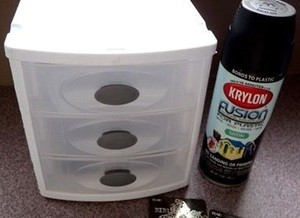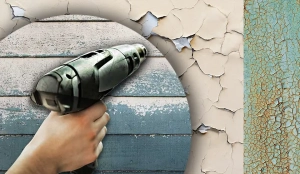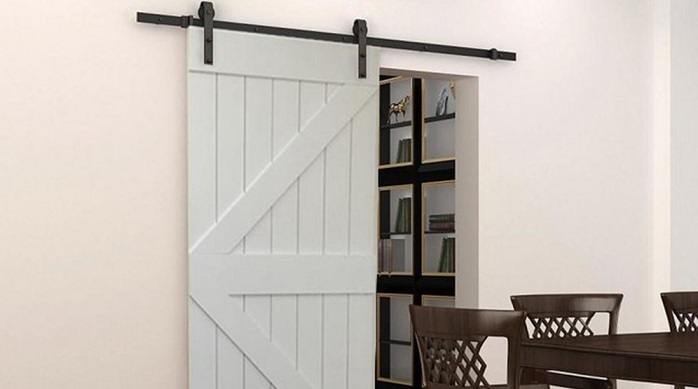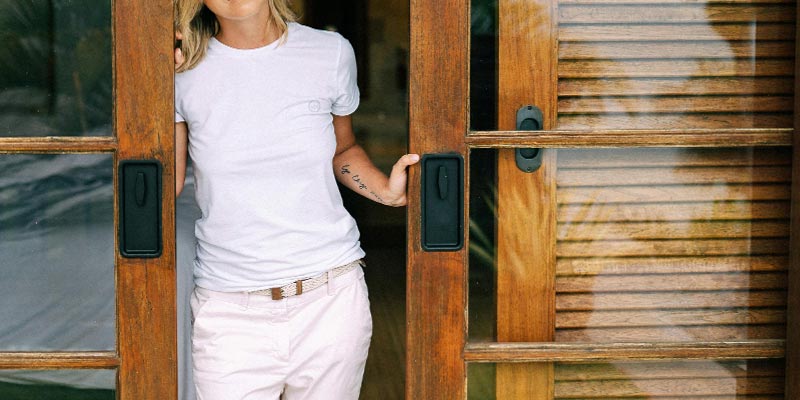Need help with your DIY house paint cost estimate? In this guide we explain how to accurately calculate your DIY paint costs, interior and exterior.
Aside from the safety that your house provides, it should be a reflection of your style and personality. You want your house to appear pleasing to the eye and soul, and create a good impression on your family, friends and neighbors.
And the first thing that most people will notice is the paint job. Not only the color, but the age of the paint. Does it look fresh and modern, or scuffed and drab? Or does it look a bit 80s and not in a good way?
Even as much as we might like to avoid it, the reality is that houses need to get re-painted over time. Either because you feel like a change in color and feel, or because it has gotten weathered and worn.

Homeowners often hire a professional painter to get the job done. However, you don’t have to. With some planning, energy and can-do attitude this is a job you can definitely DIY. By doing it yourself you can keep your house up to paint, without setting you back tens of thousands of dollars. This is no small task though, and you will need to do some meticulous planning and budgeting before you get started.
In this article, we’re going to talk about house paint cost and coverage, and guide you through the exact steps for calculating the cost to paint your house yourself, DIY-style. Grab a strong coffee, paper and pencils, your measuring tool, and get ready to dive into some painting maths.
Why you should paint a house yourself
While hiring a professional painter sounds appealing, there are great benefits when you choose to paint your home by yourself.
Aside from being a more cost-efficient alternative, you can oversee everything; from the design, planning, budget, painting, up to the precise results that you want. Of course, this isn’t appealing to a lot of people, in which case sure hiring a professional is probably a better idea.
However, if you like to be in control and don’t mind learning some new skills, then house painting is a great job to DIY. Think of it as you being the supervisor, manager and worker in one body. It may be overwhelming or scary to handle things by yourself at first, but once you realize that you can get the job done, it’s unlikely that you’ll pay a professional painter again.
Reasons to DIY house painting:
- You are in charge of the decisions
- You are free to change your mind and preferences
- You can undo and redo whenever you want
- You are likely to have wider options
- There are no additional costs in case of delays
- There is no strict timeframe to follow
Why accurately estimating paint for house is important
Now that you’ve made up your mind and are ready to paint your house yourself, you need to learn and remember the basics. One of the most important things to do before anything else is making an accurate estimate of the house paint and the materials that you need and are going to use. By doing this, you’ll be able to gauge how much money you have to shell out, as well as how many cans or gallons of paint you have to buy.
Accurately estimating paint for your house is important because:
- Saves time and money
- Makes it easier to plan your budget according to what needs to be painted
- Lessens the probability of not buying enough or having excess paint cans or materials
Important points to consider before estimating paint for house
Before starting to estimate the paint for your house, there are things that need to be considered. Especially if this is your first time painting your house by yourself, you should be careful and meticulous when it comes to making measurements and calculations. It is also important to mention that any calculation estimate is just that – an ESTIMATE. You might end up spending more or less, depending on various factors such as:
- Color of the paint (eg light on dark, or dark on light)
- Type of paint and paint finish (eg ceiling, bathroom)
- How many coats are required (eg single, double)
- Surface you are painting (eg timber, brick, drywall)
- What equipment you are using to paint (eg roller, sprayer)
How many coats are required
As a general rule and often advised by professionals, two coats of paint are required when painting your house regardless of whether it’s the interior or exterior. However, this can change depending on other factors such as the type of surface you’re going to paint, the type of paint that you’re going to use, and whether or not you’re going to use a primer.
Tips regarding paint coats:
- When painting a new wall, two coats of paint does the job but make sure to put primer first.
- When painting a ceiling, one coat of paint is enough after a primer. Make sure to pick a high-quality type of paint.
- When covering a surface with the same color and type of paint, one coat is enough. However, you can always make it two depending on whether the original paint has already faded or is crusty.
- When it comes to covering light colors with dark ones or covering dark ones with light ones, two coats are required to see promising results and maximize coverage.
Extra tip: Make sure that the surface you’re going to paint on is smooth and clean. This will make the paint last longer.
How your equipment affects coverage
There are two common ways that paint is applied on your house’s surface: it’s either by spraying or rolling. While both are effective in giving you the results that you want to see, both have their own advantages and disadvantages.
Rollers: Using a roller may get the job done as fast as spraying, but one of its disadvantages is that it drips paint everywhere, so using this can be messy and result in paint wastage. On the bright side, a roller may make the process slightly faster considering that you won’t have to set up any equipment or check on it from time to time. Remember to wipe off the excess paint on the end of your roller as you go along, to avoid messy situations and lessen wastage.
Paint Sprayers: Paint sprayers can cover large areas faster and in a more defined way. One of its disadvantages is that if you’re new to using it, you may have to go through a lot of trial and error, resulting in paint wastage. The other drawback to sprayers is that a lot of paint will end up in the air, by some estimates up to 40% can get lost in the air, depending on the type of sprayer you’re using and your technique. For more info on paint sprayers and good options, check out our article on Handheld Paint Sprayers here.
How the surface affects coverage
When it comes to what surface will give you the best coverage, a smooth surface would be the answer. However, not all surfaces are smooth. Some are textured and draw in more paint, such as wood or brick, and therefore will require more paint than a smooth surface. Applying a primer first will definitely help with this, however.
Coverage and Price of House Paint
How much for a gallon of paint (price)?
Low-quality types of paint can be purchased at $15, while higher quality paints are priced from $25 to $40. Of course, that’s not the highest price. Depending on the brand and type of paint, there are kinds that cost around $150 to $200 per gallon.
How much for a gallon of paint?
- Low Quality: From $15 per gallon
- Good Quality: $25-40 per gallon
- Premium Quality: $150-200 per gallon
What is the coverage of a gallon of paint?
According to several sources including Lowes, the coverage of gallon of paint is estimated at 350-400 square feet, with a single coat. This means that if you’re double-coating, you will need around two gallons to cover an area of 400 square feet. They also state that a gallon of primer covers 200-300 square feet.
- 1 Gallon of Paint, Single Coat = 400 square feet
- 1 Gallon of Paint, Double Coat = 200 square feet
- 1 Gallon of Primer = 200-300 square feet
DIY House Paint Cost Calculations
Now we come to some calculations – time to get your measuring tool, paper and pencil out. There are two steps to calculating your paint costs. First, calculate your painting area (square feet), and second, calculate your paint cost based on the area. First we’ll present you with a cheat sheet, then we’ll go over the calculations in detail below, as well as explain how to calculate paint cost per square foot. These principles apply to any house area, whether interior or exterior.
The following cheat sheet is based on the general recommended application of 1 coat Primer and 2 coats Paint. Adjust according to your own needs.
| STEP | ACtion | FORMULA |
|---|---|---|
| #1 | Measure length and width (or height) of the area to paint (eg wall). | Length = L Width = W |
| #2 | Calculate the Area (A), by multiplying length by width | L x W = A |
| #3 | Measure length and width of any sections within Area that you don’t want painted (eg doors, windows). We’ll call these excluded sections. | Excluded Section Length = EL Excluded Section Width = EW |
| #4 | Calculate the Excluded Area (EA), by multiplying the excluded section length x width | EL x EW = EA |
| #5 | Minus the excluded area from the wall area, to get the Painting Area (PA) | A – EA = PA |
| #6 | PRIMER: Calculate number of gallons of primer required. Rule of Thumb: 1 Gal Primer = 300 sq ft. | PA ÷ 300 = GAL (Primer) |
| #7 | PRIMER: Multiply Gallon Price (GAL$) by number of gallons. | GAL x GAL$ = PRIMER COST |
| #8 | PAINT (2 COATS): Calculate number of gallons of paint required. Rule of Thumb: 1 Gal Paint = 200 sq ft (double coat). | PA ÷ 200 = GAL (Paint) |
| #9 | PAINT (2 COATS): Multiply Gallon Price (GAL$) by number of gallons. | GAL x GAL$ = PAINT COST |
| #10 | Repeat above steps for any other areas to be painted (eg ceilings, doors) | |
| #11 | Research and add costs for painting equipment you need to purchase (eg roller, sprayers, drop cloths, brushes, thinners) | |
| #12 | Add costs from all previous steps to arrive at Grand Total Estimate |
How to Calculate House Painting Area (square feet)
Wall Paint Area
- Step 1: Take the measurements of the perimeter of your house or room (in feet). To do this, measure the length of all of your walls, and total them up to get the perimeter. This will be your total LENGTH.
- Step 2: Measure the wall height (in feet). This will be your HEIGHT.
- Step 3: Multiply the LENGTH x HEIGHT = WALL AREA. This will give you the wall paint area in square feet.
- Step 4: Minus the area of any doors, windows or trims, if you are not painting or using a different paint for these (see below). WALL AREA – DOOR/WINDOW AREA = WALL PAINT AREA
Doors, Windows, Fascia and Trim Paint Area
Measure any doors, windows and trims. Like with the walls, do this by measuring the door/window/trim length and then multiplying it by the width. This will give you the DOOR/WINDOW AREA.
Roof and Ceiling Paint Area
Measure the area of the ceiling (or roof). Like with the walls, do this by measuring the ceiling length and then multiplying it by the ceiling width. This will give you the total ceiling area.
How to Calculate House Paint Cost
This is only possible if you have already calculated the area of your house, so make sure you work that out first. When you figure out the area measurements, you can now follow these steps. For this calculation we will follow the rule of thumb we mentioned earlier:
1 gallon of paint = 400 square feet (single coat).
- Step 1: Get your WALL PAINT AREA measurement (in square feet), and divide it by 400 to determine how many gallons of paint you need. WALL PAINT AREA ÷ 400 = GALLONS
- Step 2: Research the exact wall paint you want to buy (type, color etc) and note down the cost per Gallon for it. We’ll call this GALLON PRICE. You might want to select a few paints in different price ranges if you are working within a budget.
- Step 3: Multiply the price per 1 gallon of wall paint by how many gallons of paint you need. This will give you the estimated total cost for your wall paint. GALLON PRICE x GALLONS = TOTAL PAINT COST.
Repeat the above step for any other areas you are painting such as ceilings and doors. Keep in mind, these are likely to use different paints than the walls, and therefore you should keep these calculations separate from each other.
To summarize:
- PAINT AREA ÷ 400 = GALLONS
- GALLON PRICE x GALLONS = TOTAL PAINT COST
If you are double-coating, remember to use the calculation of 1 gallon = 200 square feet instead. Or simply double your final cost.
Paint Cost per Square Foot
If you want to work out the paint cost per square foot, simply divide the sum of the estimated total cost by the area of your house.
TOTAL COST ÷ TOTAL AREA (Sq Ft) = Paint cost per square foot.
How to Calculate Primer Cost
If you are using primer, as mentioned earlier the coverage is 200-300 square feet per gallon. To keep the calculation simple, we are going to go with 300. However, if you are applying it to surfaces which you expect will require more primer (for example, rough surfaces such as timber or concrete), then you might want to use 200 as your number to get a closer estimation.
Follow the same steps as above, replacing 400 (for paint) with 300 (for primer):
- PAINT AREA ÷ 300 = GALLONS
- GALLON PRICE x GALLONS = TOTAL PRIMER COST
How much to paint the interior of a house?
To calculate the house paint cost and quantity for your interior, all you need to do is divide your interior area by 400. This is because 1 gallon of paint can cover 400 square feet, so the resulting answer after you calculate this would be the quantity of paint for your interior. After that, simply multiply the price of the paint you want to use (per gallon) with the total gallons of paint you need.
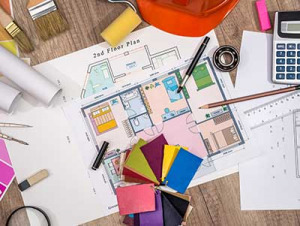
How to Calculate Ceiling Paint Cost
Step 1: Measure the LENGTH of the ceiling from corner to corner.
Step 2: After that, measure the WIDTH of the ceiling from corner to corner.
Step 3: Next, multiply both measurements to arrive at the total area in square feet. LENGTH x WIDTH = TOTAL AREA.
Step 4: Divide the TOTAL AREA (in square foot) by 400. This will give you the number of gallon-sized paint cans you’ll need to purchase.
Step 5: After that, multiply the number of cans needed by the cost per gallon of the ceiling paint you want to use.
Step 6. Repeat steps for each ceiling you want to paint.
Step 7: Finally, add up the costs for each ceiling you’ve calculated, to get the final ceiling paint cost for your entire house interior.
How to Calculate Interior Wall Paint Cost
Follow the general rule of 1 gallon of paint per 400 square feet as mentioned earlier.
Step 1: Following the previous steps, measure your interior wall area (square feet).
Step 2: Divide your wall area by 400 to determine how many gallons of paint you need. Repeat this step if you are using primer (divide by 300 instead).
Step 3: Now that you have an idea of how much paint you have to buy, research the paint you want and take note of the price per gallon.
Step 4: Multiply the price per gallon of paint by how many gallons are required, to get the cost. If you are using different colors or paints throughout your interior, do the calculations individually per paint.
Step 5: Add together all the individual costs (for each paint) to arrive at your estimated total cost.
How much does it cost to paint exterior of house?
To calculate the cost to paint exterior of house is just the same as calculating the cost to paint the interior of a house. The only difference being you are now using the exterior measurements, instead of the interior measurements. Here are the steps again:
How to Calculate Exterior Wall Paint Cost
A big difference between painting internal walls and external walls is going to be the surface you’re painting onto. For the most part, internal walls are smooth, but exterior walls can come in all sorts – brick, timber etc. We’d suggest you overestimate a bit, rather than underestimate, so you don’t fall short. Like before, follow the rule of thumb of 1 gallon of paint per 400 square feet.
Step 1: Measure the wall area in square feet, following the steps indicated earlier (multiplying length by width).
Step 2: Minus the area of any sections you are not planning to paint, such as windows and doors
Step 3: Work out the area of any additional sections to paint, such as doors, fascia, drain pipes and gutters (record these measurements separately if they are in the different color or paint type).
Step 4: If you are using primer, divide the area by 300. This will give you the number of gallons of primer you’ll need.
Step 5: For the paint, divide the area by 400. This will give you the number of gallons of paint you’ll need. If you are double-coating, divide it by 200 instead (not 400).
Step 6: Next, research your paint and primer options and costs, and jot down the price per gallon of each one.
Step 7: Multiply the paint/primer gallon price by the number of gallons that are required, to find out the total costs of each.
Step 5: Add together all the total costs, to get your estimated grand total cost to paint the exterior of your house.
Frequently Asked Questions
How to calculate cost to paint house trim and doors?
When it comes to measuring doors, all you have to do is multiply its width by its height to arrive at the number of square feet. Then, divide it by 400 to determine how many gallons of paint you need. Multiply this by the price per gallon of the paint you plan to use, and this will give you the cost. You will also have the edges of the doors and trims, but these are small areas so you might not want to bother measuring those. If you do want to add them into your measurements, you can calculate the area of the edges separately, then add those into the total area.
How much paint is needed to paint house trim and gutters?
A general rule of thumb from professionals is that one gallon of paint is enough to cover trim and gutters per eight gallons of body paint. When you add these calculations together, it will result in the amount of paint that you need.
DIY House Paint Cost Estimate Conclusion
By now, you have probably arrived at a big decision on what move you’re going to do next. Before pushing through with something, it is important to plan ahead, determine the costs, as well as make careful estimations. By doing this, you will save yourself from spending too much time, energy, and money on something that will only go to waste.
We hope you have learned a thing or two from this article about DIY house paint cost, and now have a practical guide to move forward on your paint budget calculations. Remember that home improvement is for everyone, and shouldn’t come at a high cost. You can do this!
Happy painting!
Author
-

Hey, I’m Sara, co-owner of NestKoo! I’m a graphic designer and professionally trained fine artist, with a Bachelor of Arts (Fine Art) majoring in Painting. I love being close to nature, sustainable living and bringing new life to old things. My specialty in NestKoo is DIY house painting, upholstery and furniture upcycling, where I bring my skills in fine art painting and contemporary design together into a practical home DIY context.
View all posts





